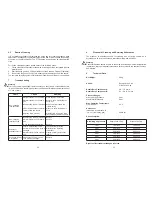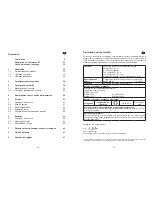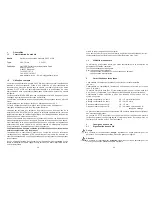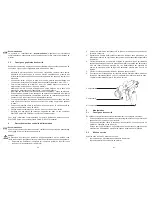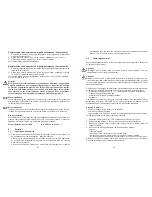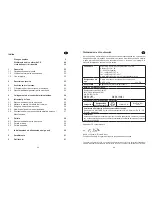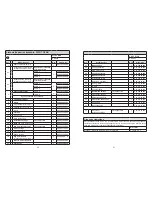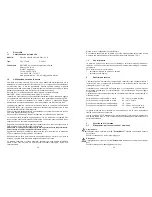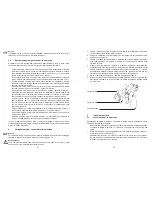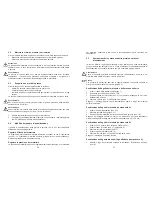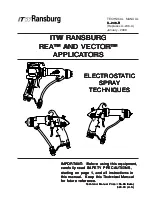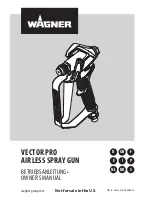
27
26
3.2
General Safety Instructions
All applicable accident prevention rules and regulations as well as other recognised
industrial safety and health rules and regulations must be observed at all times.
• Use the spray gun only in well-ventilated rooms. Fire, naked flames and smoking
are strictly prohibited within the working area. WARNING - during the spraying of
flammable materials (e.g. lacquers, adhesives, cleaning agents, etc.), there is an
increased risk to health as well as an increased risk of explosion and fire.
• Measures must be taken to ensure that the spray gun is sufficiently grounded
(earthed) by means of a conductive air hose (maximum resistance 10
6
Ω
).
• Before carrying out maintenance or servicing work, always ensure that the air
and material feed to the spray gun have been depressurised. Risk of injury!
• When spraying materials, do not place your hands or other parts of the body in
front of the pressurised nozzle or the spray gun. Risk of injury!
• Never point the spray gun at persons or animals. Risk of injury!
• Always observe the spraying and safety instructions given by the manufacturers
of the spraying material and the cleaning agent. Aggressive and corrosive
materials in particular can be harmful to health.
• Exhaust air containing particles (overspray) must be kept away from the working
area and personnel. In spite of these measures, always wear the regulation
breathing masks and protective overalls when using the gun. Airborne particles
represent a serious health hazard!
• Always wear hearing protection when using the gun or when in the vicinity of a
gun that is in use. The noise level generated by the spray gun is approx. 86 dB
(A).
• After carrying out assembly or maintenance work, always ensure that all nuts,
bolts and screw connections have been fully tightened before the gun is used.
• Use only original replacement parts, since WALTHER can only guarantee safe
and fault-free operation for original parts.
For further information on the safe use of the spray gun and the spraying materials,
please contact WALTHER Spritz- und Lackiersysteme GmbH, D-42327 Wuppertal,
Germany.
4
Connection of Input Lines
Note
Please refer to the exploded view (page 2) supplied with this manual when performing
the installation steps described on the following pages.
Warning
The air pressure of the gun must not exceed 6 bar; otherwise safe operation
of the gun cannot be guaranteed.
1. Connect the air hoses (cleaned compressed air) to the material pressure tanks
and the air inlet of the spray gun.
2. Fill the material pressure tanks for component A and component B with the
respective material and close the lid.
3. Fasten the material inlet hose to its respective material pressure tank or the
material pressure regulator, if a pump system is used, and to the material inlets
of the spray gun.
4. Switch on the pressurised air and adjust the air pressure reduction valve to the
required atomizing air pressure. Adjust the air pressure reduction valves on the
material pressure tanks to the required pressure. If the material is fed via a pump
system the pressure is adjusted via an adjusting key on the material pressure
control.
5. Open the material tap at the material outlet of the relevant pressure tank.
6. To bleed any air left left in the material hose actuate the trigger until a uniform
jet emerges from the nozzle. The spray gun is now ready for operation.
5 Operation
5.1
Safety Instructions
Please pay special attention to the following safety instructions when using the spray
gun!
•
Be sure to wear the required respiratory protection masks and protective over-
alls whenever you are operating the spray gun. Airborne particles represent a
health hazard.
•
Be sure to wear suitable ear protection. The spray gun produces sound levels
of approx. 86 dB (A).
•
No open fires, naked lights or smoking in the working area. The spraying of
readily inflammable media is accompanied by an increased risk of fire and
explosion.
5.2
Requirements at the Start and Finish of Operation
The following requirements must be met before the spray gun is operated:
•
The atomizing air pressure must be available at the gun.
•
The material pressure must be available at the gun.
Component B
Component A
Pressure air

















